
Relatives of a Moors Murder victim had her remains returned to them in a casket just days before Ian Brady’s ashes were scattered at sea in the night.
Police kept Pauline Reade’s body parts for 30 years without her family’s knowledge, before officers delivered them last week, the Manchester Evening News reported.
The 16-year-old’s jaw bone and samples of her hair were discovered at Leeds University after an audit following Brady’s death, aged 79, on May 15 at Ashworth High Security Hospital in Maghull, Merseyside.
On Friday, it was revealed that Glasgow-born Brady’s death-bed wishes were ignored as he was cremated and disposed of without ceremony.
His body was collected from the mortuary at Royal Liverpool Hospital by a Tameside Council official at around 9pm on Wednesday October 25, newly released court documents show.
It was then taken under police escort to Southport Crematorium, where the cremation began at 10pm exactly. No music or flowers were allowed.
Following this, Brady’s ashes were placed in a weighted biodegradable urn, driven to Liverpool Marina and dispatched at sea on Thursday October 26 at 2.30am.
The serial killer’s crimes shocked the nation as he tortured and murdered five children in the 1960s along with Myra Hindley, who died in prison in 2002.
There were fears that the remains of Brady would be scattered on Saddleworth Moor – where the couple buried four of their victims.
Brady’s executor, Robin Makin, gave assurances that there was “no likelihood” of this happening, but the Chancellor of the High Court, Sir Geoffrey Vos, ruled in October that the issue of disposal should be taken out of Mr Makin’s hands.
 Keith Bennett and Pauline Reade were among Brady’s victims (PA)
Keith Bennett and Pauline Reade were among Brady’s victims (PA)
Pauline Reade disappeared on her way to a disco on July 12 1963 and John Kilbride, 12, was snatched in November the same year. Keith Bennett was taken on June 16 1964 after he left home to visit his grandmother, Lesley Ann Downey, 10, was lured away from a funfair on Boxing Day 1964, and Edward Evans, 17, was killed in October 1965.
Brady and Hindley later confessed to the murders of Pauline and Keith, whose body has never been found.
Pauline’s body was only discovered in 1987 following a search of Saddleworth Moor and her family believed they had finally laid her to rest after a funeral ceremony.
This week, Greater Manchester Police (GMP) delivered a wooden casket holding the teenager’s remains to solicitors for her niece, Jackie Reade.
 Police search for the bodies of Pauline Reade and Keith Bennett on Saddleworth Moor (PA)
Police search for the bodies of Pauline Reade and Keith Bennett on Saddleworth Moor (PA)
Ms Reade, 44, from Wythenshawe, said: “I am devastated. It has brought it all back. I am disgusted that part of Pauline could be kept like this.
“I was 13 when Pauline was found. I remember the day very clearly. My nana and grandad, (Pauline’s parents) Joan and Amos, were still alive at the time.”
Martin Bottomley, head of GMP’s Cold Case Unit, said: “We recently became aware that human tissue belonging to Pauline Reade had been stored in external premises on behalf of GMP.
“The samples had originally been kept for investigative purposes. As soon as we became aware of this, we contacted Pauline’s family to make arrangements so that the samples could be laid to rest in whichever way they felt most fitting.
“This is a deeply sensitive matter and understandably it has caused some upset with the family; however, we felt contacting them was the right thing to do and we have given them a number of options, all of which GMP will pay for.”


Why are you making commenting on The Herald only available to subscribers?
It should have been a safe space for informed debate, somewhere for readers to discuss issues around the biggest stories of the day, but all too often the below the line comments on most websites have become bogged down by off-topic discussions and abuse.
heraldscotland.com is tackling this problem by allowing only subscribers to comment.
We are doing this to improve the experience for our loyal readers and we believe it will reduce the ability of trolls and troublemakers, who occasionally find their way onto our site, to abuse our journalists and readers. We also hope it will help the comments section fulfil its promise as a part of Scotland's conversation with itself.
We are lucky at The Herald. We are read by an informed, educated readership who can add their knowledge and insights to our stories.
That is invaluable.
We are making the subscriber-only change to support our valued readers, who tell us they don't want the site cluttered up with irrelevant comments, untruths and abuse.
In the past, the journalist’s job was to collect and distribute information to the audience. Technology means that readers can shape a discussion. We look forward to hearing from you on heraldscotland.com
Comments & Moderation
Readers’ comments: You are personally liable for the content of any comments you upload to this website, so please act responsibly. We do not pre-moderate or monitor readers’ comments appearing on our websites, but we do post-moderate in response to complaints we receive or otherwise when a potential problem comes to our attention. You can make a complaint by using the ‘report this post’ link . We may then apply our discretion under the user terms to amend or delete comments.
Post moderation is undertaken full-time 9am-6pm on weekdays, and on a part-time basis outwith those hours.
Read the rules here